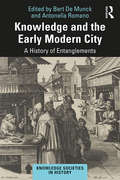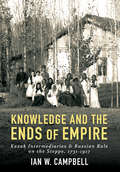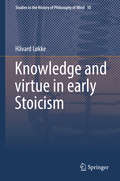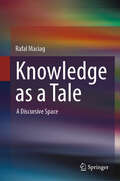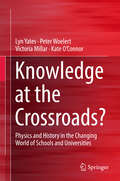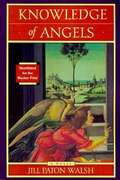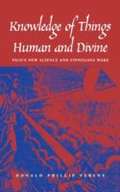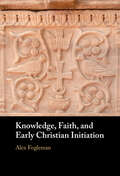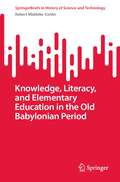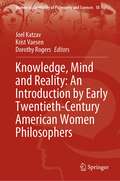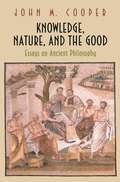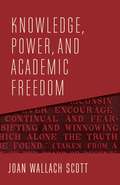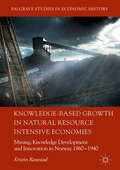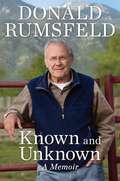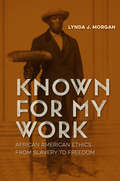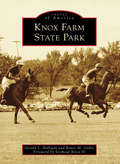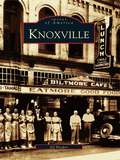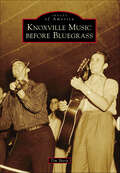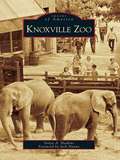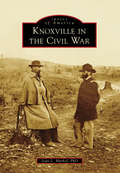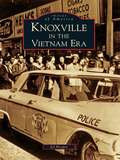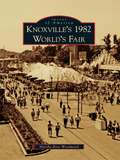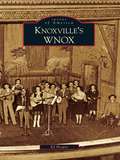- Table View
- List View
Knowledge and the Early Modern City: A History of Entanglements (Knowledge Societies in History)
by Antonella Romano Bert De MunckKnowledge and the Early Modern City uses case studies from the sixteenth to the eighteenth centuries to examine the relationships between knowledge and the city and how these changed in a period when the nature and conception of both was drastically transformed. Both knowledge formation and the European city were increasingly caught up in broader institutional structures and regional and global networks of trade and exchange during the early modern period. Moreover, new ideas about the relationship between nature and the transcendent, as well as technological transformations, impacted upon both considerably. This book addresses the entanglement between knowledge production and the early modern urban environment while incorporating approaches to the city and knowledge in which both are seen as emerging from hybrid networks in which human and non-human elements continually interact and acquire meaning. It highlights how new forms of knowledge and new conceptions of the urban co-emerged in highly contingent practices, shedding a new light on present-day ideas about the impact of cities on knowledge production and innovation. Providing the ideal starting point for those seeking to understand the role of urban institutions, actors and spaces in the production of knowledge and the development of the so-called ‘modern’ knowledge society, this is the perfect resource for students and scholars of early modern history and knowledge.
Knowledge and the Ends of Empire: Kazak Intermediaries and Russian Rule on the Steppe, 1731-1917
by Ian W. CampbellIn Knowledge and the Ends of Empire, Ian W. Campbell investigates the connections between knowledge production and policy formation on the Kazak steppes of the Russian Empire. Hoping to better govern the region, tsarist officials were desperate to obtain reliable information about an unfamiliar environment and population. This thirst for knowledge created opportunities for Kazak intermediaries to represent themselves and their landscape to the tsarist state. Because tsarist officials were uncertain of what the steppe was, and disagreed on what could be made of it, Kazaks were able to be part of these debates, at times influencing the policies that were pursued.Drawing on archival materials from Russia and Kazakhstan and a wide range of nineteenth-century periodicals in Russian and Kazak, Campbell tells a story that highlights the contingencies of and opportunities for cooperation with imperial rule. Kazak intermediaries were at first able to put forward their own idiosyncratic views on whether the steppe was to be Muslim or secular, whether it should be a center of stock-raising or of agriculture, and the extent to which local institutions needed to give way to imperial institutions. It was when the tsarist state was most confident in its knowledge of the steppe that it committed its gravest errors by alienating Kazak intermediaries and placing unbearable stresses on pastoral nomads. From the 1890s on, when the dominant visions in St. Petersburg were of large-scale peasant colonization of the steppe and its transformation into a hearth of sedentary agriculture, the same local knowledge that Kazaks had used to negotiate tsarist rule was transformed into a language of resistance.
Knowledge and the Public Interest, 1575–1725
by Vera KellerMany studies relate modern science to modern political and economic thought. Using one shift in order to explain the other, however, has begged the question of modernity's origins. New scientific and political reasoning emerged simultaneously as controversial forms of probabilistic reasoning. Neither could ground the other. They both rejected logical systems in favor of shifting, incomplete, and human-oriented forms of knowledge which did not meet accepted standards of speculative science. This study follows their shared development by tracing one key political stratagem for linking human desires to the advancement of knowledge: the collaborative wish list. Highly controversial at the beginning of the seventeenth century, charismatic desiderata lists spread across Europe, often deployed against traditional sciences. They did not enter the academy for a century but eventually so shaped the deep structures of research that today this once controversial genre appears to be a musty and even pedantic term of art.
Knowledge and virtue in early Stoicism (Studies in the History of Philosophy of Mind #10)
by Håvard LøkkeThis book is about the epistemological views and arguments of the early Stoics. It discusses such questions as: How is knowledge possible, and what is it? How do we perceive things and acquire notions of them? Should we rely on arguments? How do we come to make so many mistakes?The author tries to give a comprehensive and conservative account of Stoic epistemology as a whole as it was developed by Chrysippus. He emphasizes how the epistemological views of the Stoics are interrelated among themselves and with views from Stoic physics and logic.There are a number of Stoic views and arguments that we will never know about. But there are passages on Stoic epistemology in Sextus Empiricus, Galen, Plutarch, Cicero, and a few others authors. The book is like a big jigsaw puzzle of these scattered pieces of evidence.
Knowledge as a Tale: A Discursive Space
by Rafal MaciagThis text describes the process that led to knowledge becoming the most important modern good and a complex phenomenon beginning at the end of the 19th century. It was a change in the way of understanding the world proposed by mathematics and geometry. This volume reveals how the paradigm shift, still in progress, is gradually transforming less obvious fields of science, such as the humanities and social sciences while affecting the phenomenon of knowledge. Firstly, meta-analysis gained importance, and secondly, it became natural to perceive knowledge in a social context, showing its diverse and multi-cause dispersion, leading to the phenomenon of knowledge. Due to the interpretation of knowledge as a complex social phenomenon, the author proposes a new model of knowledge description, called the theory of discursive space, making it possible to describe the role and meaning of knowledge as a component of modern civilization that is all-encompassing. This text appeals to students and researchers working in the philosophy of technology.
Knowledge at the Crossroads?
by Lyn Yates Peter Woelert Victoria Millar Kate O'ConnorThere is much discussion about what needs to change in education institutions in the 21st century, but less attention given to how core disciplinary studies should be considered within that context. This book is based on a major 4-year research study of history and physics in the changing environment of schools and universities in Australia. Are these forms of knowledge still valuable for students? Are they complementary to, or at odds with the concerns about '21st century skills', interdisciplinary and collaborative research teams, employability and 'learner-centred' education? How do those who work in these fields see changes in their disciplines and in their work environment? And what are the similarities and differences between the experiences of teachers and academics in physics and those in history? The book draws on interviews with 115 school teachers and university academics to provide new perspectives on two important issues. Firstly, how, for the purposes of today's schools and universities, can we adequately understand knowledge and knowledge building over time? Secondly, what has been productive and what has been counter-productive in recent efforts to steer and manage the changes in Australia?
Knowledge of Angels
by Jill Paton WalshAmara is abandoned as an infant, raised by wolves then captured by shepherds. She is sent to a convent where she becomes the object of an experiment to determine whether knowledge of God is innate. Palinor, an atheistic humanist prince and castaway seeks refuge on the island but is persecuted by the Catholic Church. Beneditx, a pious scholar, attempts to persuade Palinor that God exists. With the arrival of a special inquisitor from Rome, the clash between secular and conservative ecclesiastical values moves inexorably toward a gruesome climax.
Knowledge of Life
by Kaye PriceKnowledge of Life is the first textbook to provide students with a comprehensive guide to Aboriginal and Torres Strait Islander Australia. The result of extensive research and experience, it offers fresh insights into a range of topics and, most importantly, is written by Aboriginal and Torres Strait Islander academics. It addresses topics ranging from history and reconciliation, to literature and politics, to art, sport and health. It presents social, cultural and political perspectives on these areas in a manner that is accessible to undergraduate students from a range of backgrounds and academic disciplines. Each chapter opens with a précis of the author's journey to engage students and offer them an insight into the author's experiences. These authentic voices encourage students to think about the wider issues surrounding each chapter and their real-life implications. This timely publication emphasises the importance of relationships between non-Indigenous and Aboriginal and Torres Strait Islander cultures.
Knowledge of Things Human and Divine: Vico's New Science and Finnegans Wake
by Donald Phillip VereneThis book takes the reader through the career and works of Giambattista Vico (1668-1744) from a new viewpoint. Two major figures introduced Vico to the twentieth century -- Benedetto Croce and James Joyce. From the mid-twentieth century on there was a growing desire to free Vico from the philosophical idealism of Croce, who in the early part of the century had presented Vico as the Italian Hegel.
Knowledge, Faith, and Early Christian Initiation
by Alex FoglemanIn this book, Alex Fogleman presents a new history of the rise and development of catechesis in Latin Patristic Christianity by focusing on the critical relationship between teaching and epistemology. Through detailed studies of key figures and catechetical texts, he offers a nuanced account of initiation in the Early Christian era to explore fundamental questions in patristic theology: What did early Christians think that it meant to know God, and how could it be taught? What theological commitments and historical circumstances undergirded the formation of the catechumenate? What difference did the Christian confession of Jesus Christ as God-made-flesh make for practices of Christian teaching? Fogleman's study provides a dynamic narrative that encompasses not only the political and social history of Christianity associated with the Constantinian shift in the fourth century but also the modes of teaching and communication that helped to establish Christian identity. This title is part of the Flip it Open Programme and may also be available Open Access. Check our website Cambridge Core for details.
Knowledge, Literacy, and Elementary Education in the Old Babylonian Period (SpringerBriefs in History of Science and Technology)
by Robert Middeke-ConlinThis book examines education as a means to explore knowledge and literacy in the Old Babylonian period. It further employs a new method to research these topics. Contrary to numerous existing studies on the subject, the author examines elementary education globally, that is, in pursuit of Old Babylonian education in its entirety. Typically, education is examined in a piecemeal fashion. It's as if education centered on lexicography alone or mathematics alone. This work encompasses a view about educational content and knowledge systems, as opposed to only specific aspects or branches of them. In doing so, a characterization of institution and society is made possible allowing the work to open new general perspectives on Mesopotamian knowledge, literacy, and education.
Knowledge, Mind and Reality: An Introduction by Early Twentieth-Century American Women Philosophers (Women in the History of Philosophy and Sciences #18)
by Joel Katzav Krist Vaesen Dorothy RogersThis book is the first volume featuring the work of American women philosophers in the first half of the twentieth century. It provides selected papers authored by Mary Whiton Calkins, Grace Andrus de Laguna, Grace Neal Dolson, Marjorie Glicksman Grene, Marjorie Silliman Harris, Thelma Zemo Lavine, Marie Collins Swabey, Ellen Bliss Talbot, Dorothy Walsh and Margaret Floy Washburn. The book also provides the historical and philosophical background to their work. The papers focus on the nature of philosophy, knowledge, the philosophy of science, the mind-matter nexus, the nature of time, and the question of freedom and the individual. The material is suitable for scholars, researchers and advanced philosophy students interested in (history of) philosophy; theories of knowledge; philosophy of science; mind, and reality.
Knowledge, Nature, and the Good: Essays on Ancient Philosophy
by John M. CooperKnowledge, Nature, and the Good brings together some of John Cooper's most important works on ancient philosophy. In thirteen chapters that represent an ideal companion to the author's influential Reason and Emotion, Cooper addresses a wide range of topics and periods--from Hippocratic medical theory and Plato's epistemology and moral philosophy, to Aristotle's physics and metaphysics, academic scepticism, and the cosmology, moral psychology, and ethical theory of the ancient Stoics. Almost half of the pieces appear here for the first time or are presented in newly expanded, extensively revised versions. Many stand at the cutting edge of research into ancient ethics and moral psychology. Other chapters, dating from as far back as 1970, are classics of philosophical scholarship on antiquity that continue to play a prominent role in current teaching and scholarship in the field. All of the chapters are distinctive for the way that, whatever the particular topic being pursued, they attempt to understand the ancient philosophers' views in philosophical terms drawn from the ancient philosophical tradition itself (rather than from contemporary philosophy). Through engaging creatively and philosophically with the ancient texts, these essays aim to make ancient philosophical perspectives freshly available to contemporary philosophers and philosophy students, in all their fascinating inventiveness, originality, and deep philosophical merit. This book will be treasured by philosophers, classicists, students of philosophy and classics, those in other disciplines with an interest in ancient philosophy, and anyone who seeks to understand philosophy in philosophical terms.
Knowledge, Power, and Academic Freedom (The Wellek Library Lectures)
by Joan Wallach ScottAcademic freedom rests on a shared belief that the production of knowledge advances the common good. In an era of education budget cuts, wealthy donors intervening in university decisions, and right-wing groups threatening dissenters, scholars cannot expect that those in power will value their work. Can academic freedom survive in this environment—and must we rearticulate what academic freedom is in order to defend it?This book presents a series of essays by the renowned historian Joan Wallach Scott that explore the history and theory of free inquiry and its value today. Scott considers the contradictions in the concept of academic freedom. She examines the relationship between state power and higher education; the differences between the First Amendment right of free speech and the guarantee of academic freedom; and, in response to recent campus controversies, the politics of civility. The book concludes with an interview conducted by Bill Moyers in which Scott discusses the personal experiences that have informed her views. Academic freedom is an aspiration, Scott holds: its implementation always falls short of its promise, but it is essential as an ideal of ethical practice. Knowledge, Power, and Academic Freedom is both a nuanced reflection on the tensions within a cherished concept and a strong defense of the importance of critical scholarship to safeguard democracy against the anti-intellectualism of figures from Joseph McCarthy to Donald Trump.
Knowledge-Based Growth in Natural Resource Intensive Economies: Mining, Knowledge Development and Innovation in Norway 1860–1940 (Palgrave Studies in Economic History)
by Kristin RanestadThis book rejects the idea that natural resource industries are doomed to slow growth. Rather, it examines the case of Norway to demonstrate that such industries can prove highly innovative and dynamic.Here, the case is compellingly made that a key empirical problem with the popular ‘resource curse’ argument is that some of the richest countries in the world – namely Norway, Sweden, Canada and Australia – have all developed fast-growing economies based on natural resources. Analysis of innovation and knowledge development in natural resource industries reveal important new insights about the role of learning and innovation. These insights are key to understanding variances in growth levels between natural resource-based economies. Ranestad illustrates how Norway’s high economic performance is built on knowledge-based natural resource industries. While Norwegian industries may have originated because of foreign technology and expertise, they thrived due to further developments carried out by organisations within Norway. Ranestad looks at how these developments were possible due to the country’s high level of human capital, capacity for knowledge absorption and ability to adapt to new global technological and economic circumstances.
Known and Unknown: A Memoir
by Donald RumsfeldRumsfeld addresses the challenges and controversies of his career, from the unseating of the entrenched House Republican leader in 1965, to helping the Ford administration steer the country away from Watergate and Vietnam, to bruising battles over transforming the military for the 21st century, to the war in Iraq, to confronting abuse at Abu Ghraib and allegations of torture at Guantanamo Bay.
Known for My Work: African American Ethics from Slavery to Freedom
by Lynda J. Morgan“Demonstrates that the ‘emancipation generation’ bequeathed values, ethical frameworks, and identities to multiple ensuing generations, shaping religious, educational, and cultural institutions as well as labor and political organizations.”—Peter Rachleff, editor of Starving Amidst Too Much and Other IWW Writings on the Food Industry “Shows how far off the mark arguments are that claim that black Americans generally have internalized inferiority and engage in self-defeating behaviors.”—William A. Darity Jr., coeditor of Boundaries of Clan and Color: Transnational Comparisons of Inter-Group Disparity In Known for My Work, Lynda Morgan looks beyond slavery’s legacy of racial and economic inequality and counters the idea that slaves were unprepared for freedom. By examining African American social and intellectual thought, Morgan highlights how slaves built an ethos of “honest labor” and collective humanism. As moral economists, slaves and their descendants insisted that economic motives formed the foundation of their exploitation and made sophisticated arguments about the appropriate role of labor in a just and democratic society. Morgan considers how slaves evaluated the violence, coercions, and deceits employed by slaveholders as means to maintain power, as well as the ways in which fugitive slaves active in the abolition movement stressed to nonslaveholding audiences how they were complicit in a regime fraught with moral decay. She also points to the racial rhetoric of Jim Crow architects and how it was readily identified as elaborating on slave-era racial propaganda in new ways for an old reason: to establish a rigid economic inequality in the Industrial Revolution. From the late antebellum era through Reconstruction, labor organizing in the 1930s and 1940s, the civil rights movement of the 1960s and 1970s, and the reparations movement of the twenty-first century, Morgan offers an unprecedented view of African America. What emerges from the literature is a clear critique of racism, an embrace of self-defense, and the belief that they deserved reparations for lost labor. Enslaved laborers thought for themselves, imagined themselves, and made themselves. Moreover, their descendants share this moral legacy as a foundation for citizenship and participation in democracy.
Knox Farm State Park
by Renee M. Oubre Gerald L. HalliganA stone wall along Seneca Street in East Aurora, New York, welcomes visitors to Knox Farm State Park with its charming buildings, woodlands, and open fields. The farmland was purchased by Seymour H. Knox, an entrepreneur from Russell, New York. Successful in the five-and-dime store industry with his cousin F.W. Woolworth, Knox expanded his business interests to include raising horses and developing a self-sustaining farm. Following his death in 1915, his family maintained and expanded the property, gracing it with architectural features reflecting their interests. In the 1990s, with the passing of Seymour Knox II and sons, the family's desire to preserve the beloved property was fulfilled with the establishment of Knox Farm State Park.
Knoxville (Images of America)
by Ed HooperThough it began as a small fort on the Tennessee River, Knoxville would not know obscurity for long. Founded in 1791, Knoxville became the capital of the new state of Tennessee five years later and rapidly became a major metropolitan area for the southeastern United States. Exportations of raw and natural goods brought wealth and new residents, and soon its main thoroughfare became a window into the growth, development, decline, and rebirth of an all-American city. Then, as now, all roads downtown lead to Gay Street, and everything Knoxville came from it.Though Knoxville is a decidedly Southern city, it has also taken its place within the American melting pot. Swiss, English, Dutch, Irish, German, Greek, African, and Spanish families have all played major roles in the city's development. For many years, at one small popcorn stand on Gay Street stood Gary Crowder-the meticulous owner of the amazing collection of photographs predominantly featured in Images of America: Knoxville.
Knoxville Music before Bluegrass (Images of America)
by Tim SharpSince colonial times, generations of families from Ireland, Scotland, Wales, and England have settled in Knoxville and East Tennessee. Early on, they arrived with ballads, stories, instruments, and folk music from their former homes. "Songcatchers," including Francis James Child, Olive Dame Campbell, Maud Pauline Karpeles, Cecil J. Sharp, William Francis Allen, Lucy McKim Garrison, Charles Pickard Ware, and George Pullen Jackson, journeyed deep into the remotest areas of East Tennessee to capture their songs in the late 19th and early 20th centuries. This music existed almost unchanged until the introduction of commercial recording and radio broadcasting in the 1920s. The historic recording sessions in Bristol, Tennessee, in the summer of 1927 sparked new genres of music, and through the contribution of musicians like Lester Flatt, Josh Graves, Dolly Parton, Earl Scruggs, Ralph Stanley, the Carter Family, Bill Monroe, and many others, Knoxville and East Tennessee are acknowledged for the roles they played in the birth of country and bluegrass music.
Knoxville Zoo (Images of America)
by Jack Hanna Sonya A. HaskinsThe Knoxville Zoo began as the Birthday Park Zoo in 1948. Due to a lack of expertise and funding, the Humane Society started proceedings to close the zoo in 1971 after the animals' welfare came under scrutiny. The zoo was saved by Guy Smith, a local television executive, who took on the job as the zoo's first director at a salary of $1 per year. Smith managed to convince the City of Knoxville and the local community to invest in this wonderful sanctuary. As the zoo's conditions improved and awareness was raised, a focus was placed on breeding threatened or endangered animals. These efforts were rewarded in 1978 with the birth of the first two African elephants to be born in the western hemisphere. This book celebrates the zoo's fascinating history with approximately 200 black-and-white images and detailed captions of its birth, rebirth, and journey toward becoming one of the nation's premier zoological institutions. This is a keepsake that zoo visitors and wildlife enthusiasts alike will enjoy.
Knoxville in the Civil War (Images of America)
by Joan MarkelKnoxville sits nestled in the extraordinary natural beauty of the Tennessee River Valley. For four long years, from 1861 to 1865, this idyllic setting was racked by some of the harshest experiences of the entire Civil War. Armies, battles, famous generals, partisans, and thousands of troops from every state North and South made their mark on the region, leaving a rich military history. However, it was the people of this genuinely American city whose divided loyalties forced families, schools, churches, financial stability, and literally all aspects of community to opposite sides of the deadly conflict. Civil war means that people, not just designated armies, become sworn enemies. In this close-knit small town, there was nowhere to hide from this vicious reality. The population of Knoxville suffered intensely, and the trauma of those punishing times can still be felt in its 21st-century cultural identity.
Knoxville in the Vietnam Era (Images of America)
by William Edward HooperThe Vietnam War era (1961-1975), one of our country's most turbulent periods, was also a time of change and social evolution. Seeded in the aftermath of World War II, the nation enjoyed a remarkable economic boom. Knoxville and East Tennessee stood witness to the transformation of American society and the problems that came with the new success. From the first recognized combat casualty of the Vietnam War to the evacuation of Saigon, Knoxvillians were there, and their stories of sacrifice and service earned little mention or were forgotten in historical texts. At home, urban decay gained a grip on Knoxville's once vibrant downtown, and protests were not an uncommon sight on the evening news, but there was progress too. This volume documents the start of a new beginning for Knoxville as the city tried to hold onto its traditional Appalachian values and move into a new era.
Knoxville's 1982 World's Fair
by Martha Rose WoodwardFrom May 1 through October 31, 1982, Knoxville hosted the world's fair based on the theme "Energy Turns the World." Expo '82 was the first world's fair to be held in the southeastern United States in 97 years, hosting 22 countries and more than 11 million people. Once referred to as the "scruffy little city by the Tennessee River," Knoxville provided one big party for people to visit from all over to witness the live entertainment, parades, displays, exhibits, musical and sporting events, food, costumes, rides, games, and arcades. The news reports of the day declared the "World Came to Knoxville" as it hosted the official international exposition, fully licensed and sanctioned by the Bureau des Expositions Internationales in Paris, France.
Knoxville's WNOX
by Ed HooperWNOX was the eighth radio station to sign on the air in North America and the first in Tennessee. No station has left a bigger footprint on American popular music or the radio industry as WNOX. Its AM signal could be heard as far south as Daytona Beach and as far north as New York City in the day of uncluttered airwaves. It helped write the book on radio broadcasts and productions with programs like the Mid-Day Merry-Go-Round and the Tennessee Barn Dance. Its legendary programs helped pioneer an entire genre of American popular music and served as a launching pad for country music's greatest stars and some of the nation's best broadcasters. The call letters remain an iconic landmark of Knoxville and East Tennessee.
